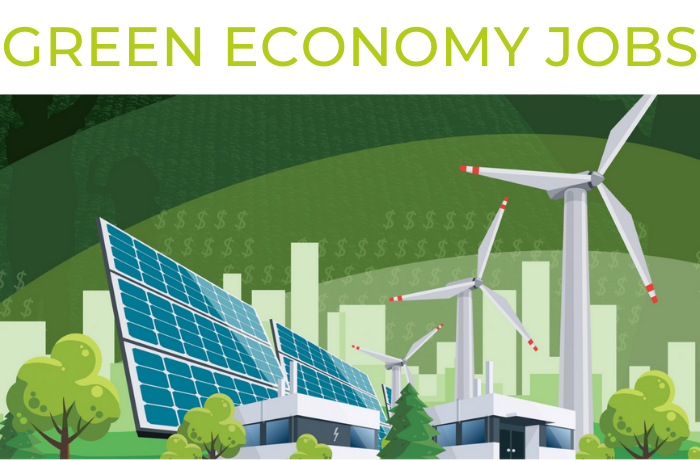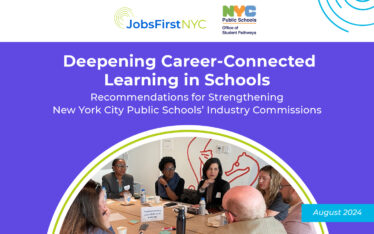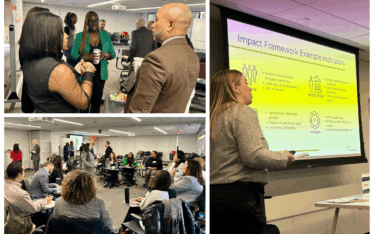Policy Proposals for Economic Growth and Climate Resilience
Building an inclusive green economy in New York City and across New York State requires understanding the knowledge and skills needed to execute climate, resiliency and circular economy priorities most effectively, while also growing a sustainable pipeline of good jobs. This is why in December 2020 JobsFirstNYC together with The HOPE Program, Nontraditional Employment for Women, and Green City Force launched the Green Economy Network in New York City. The Network establishes effective practices and aligns current systems to create green jobs and career paths, with a priority on access and sustainability, to achieve a just and sustainable economy in which quality green jobs are accessible to everyone.
More than 150 people representing over 100 different workforce development organizations, government agencies, private businesses, educational institutions and more have contributed to building the Network. The Network leverages its collective voice to advocate for policies that overlap workforce development and environmental priorities.
The green economy is large and growing fast. In 2020 investors poured more than $500 billion into the energy transition, aka decarbonization, more than any year this century. Even by a conservative definition green jobs rose by a fifth from 2015 to 2020 and already well exceed three million. By a broader definition there are already almost two million green jobs in New York State alone. Many more are yet to come: a decade ago the total cost of wind and solar power exceeded coal, but today they are roughly half coal’s cost. New York has vast offshore wind potential, over a million buildings that need energy retrofits, and nearly two million ICE vehicles that may be replaced by electric vehicles. These represent pools of potential job creation and emissions reduction.
New York State and City have done more in recent years to promote environmental legislation and policies, notably with NYS’ Climate Leadership and Community Protection Act and NYC’s Climate Mobilization Act, both passed in 2019. The former commits the state to 100% zero-emission electricity by 2040, and a reduction of at least 85% below 1990-level GHG emissions by 2050. The latter incorporates numerous local laws but the most important is Local Law 97, which requires most buildings larger than 25,000 square feet to meet energy reduction targets or owners must pay substantial fines. In April 2022 NYS approved two ultra high voltage direct current lines that will bring clean electricity to New York. These lines are crucial after the closure of the Indian Point nuclear plant in 2021, after which NYC’s share of clean electricity fell from 21% to 3%. Yet despite these laws and additional funding in the FY 2023 New York State budget, almost all state and city environmental legislation fails to incorporate workforce development and vice-versa.
Including workforce development as a priority in new legislation will be key to building an inclusive green economy, as too many New Yorkers lack the knowledge and skills to enter sustainable middle-class green careers. The green economy — which includes everything from HVAC to electric vehicle (EV) repair to energy efficiency software — has created and will create many thousands of jobs in NYC, but too few people know about these opportunities. New York State and especially New York City should diversify and improve its investment for green economy training and job creation.
Due to the lack of workforce development inclusion in the recent legislations, the Network submitted seven policy proposals to Mayor-Elect Adams’ transition team — several Green Economy Network CEOs sat on his transition committees — and to James Gennaro, the chair of the City Council’s Environmental Protection Committee, who spoke at this month’s Network meeting. The policies cover many topics, but primarily focus on workforce development, fiscal savings, and safety in the face of climate threats. For example one proposal is to create a city Youth Climate Corps. This would create a permanent corps of 1000 people who would do outreach to families to install free water- and electricity-saving equipment, help New Yorkers who face mold, flooding, or heat issues by directing them to city agencies for assistance and to reduce their bills with upgraded appliances at discounted prices from Con Edison and National Grid. By putting these young people into resume-building jobs they begin to build the skills and connections to launch their careers. For roughly $10,000 the city or a workforce developer can train someone with marketable skills and help that person start a career, one that’s difficult to outsource or automate.
These proposals are not just for young adults. Most of them would train or retrain people of any age with the skills to (re)enter the green economy in construction, infrastructure, parks, EVs, and other resiliency and sustainability sectors. We estimate that enacting all of these proposals would create over 60,000 jobs directly, which may create another 15,000 or more jobs indirectly.
The Green Economy Network and these proposed policy solutions seek to make New York a more equitable and inclusive city, where all New Yorkers benefit from the greening of the economy. Sustainability is needed in many employment sectors and as such beyond advocacy and skills training the Green Economy Network will develop relationships with companies across all sectors who will need skilled talent for the growing green jobs market. You can read the Green Economy Network’s policy proposals here, with short descriptions below:
1. Empowering Green Jobseekers and Green Businesses
Turn Small Business Service’s small programs into large job-creation machines. Companies spend large sums to train people in house and deal with high turnover. Better to let experts train workers who want to stay as part of the city’s larger workforce development strategy.
2. Local Law 97
Local Law 97, with the goal to reduce the emissions produced by the city’s largest buildings 40 percent by 2030 and 80 percent by 2050, will create jobs. Tweaked, LL 97 can reduce the same amount of emissions but do so faster while creating more and better jobs. Those building retrofits will help to improve thermal safety and reduce flood risks, critical as NYC confronts climate change.
3. Electric Vehicles (22.5k jobs)
Electric vehicles are not just about greenhouse gases. ICE vehicles are big sources of NOx, COx, PM, and other harmful pollutants. Reducing the number of ICE vehicles will protect New Yorkers’ health, especially in the outer boroughs where vehicle traffic is heavier. Creating the infrastructure to support EVs and train people to maintain them will preserve and create tens of thousands of jobs while centering New York as the regional or even national market leader in green vehicle tech.
4. Climate Corps, Education, and Parks (31k jobs):
The City Cleanup Corps used $284m in federal funding to create 10,000 temporary positions. By revamping the program as a City Climate Corps, the city can further its environmental and workforce development goals.
5. Resiliency (10k jobs):
Resiliency is not about protecting buildings but about protecting people. It means that when a storm hits, people’s homes aren’t flooded, they don’t lose electricity, and they can safely access essential goods and services. Resiliency protects people from floods and heat, ensuring stable power and storage, and that people can physically access food and medical care during floods. Improving resiliency not only protects people but also creates construction, trades, and other green jobs.
6. Fully-Empowered Climate Officer
Mayor Adams made a big step in creating a chief climate officer and consolidating the city’s environmental agencies. The next step should be to empower this climate office with the tools to measure the city’s environmental progress and green workforce development.
7. NYCHA Sustainability (1000 jobs)
Create a sustainability force that builds resiliency, helps NYCHA residents to understand green economy opportunities, and improves the sustainability of NYCHA buildings.
The Network’s lead partners1 and four working groups — Strategy, Training & Wraparound Services, Employer Partnerships & Economic Opportunity, and Policy & Advocacy — are advancing the goals of the Network. For its next project, the Network is developing a green economy systems map of New York City’s. To get involved with the Green Economy Network, contact Keri Faulhaber at kfaulhaber@jobsfirstnyc.org.
1Association for Energy Affordability, Chris Collins, Green City Force, The HOPE Program, Jewish Community Center of Staten Island, Kingsborough Community College, Nontraditional Employment for Women, Solar One, Ulster County New York – Department of the Environment




